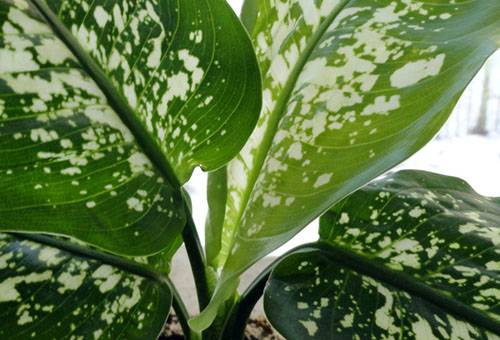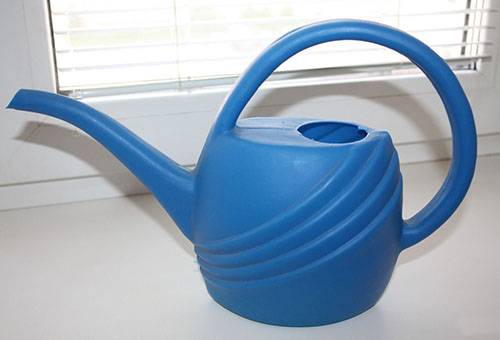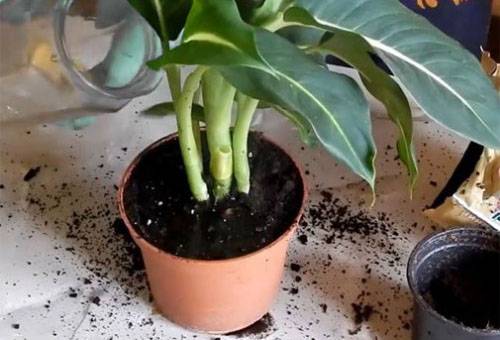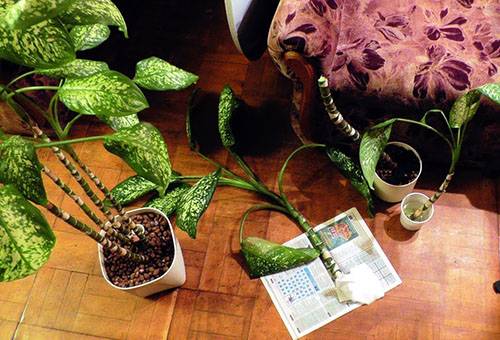Features of care of dieffenbachia at home, transplantation and reproduction
Content:
Many flower growers hesitate to grow Dieffenbachia, home care of which may seem rather difficult. But this plant of the aroid family is able to give comfort to any room. Its value lies in large oval leaves. They are decorated with unusual patterns, depending on the variety: these can be “blots”, stripes or stains on a dark green background.
Difficulties in growing Dieffenbachia
Despite the beauty, due to some properties of Dieffenbachia, it is often feared to keep in the house.
- These indoor plants are poisonous, like most members of this family. Care must be taken when caring for them. In addition, it is important to ensure that children and animals do not have access to them.
- Dieffenbachia is characterized by rapid growth; new leaves appear on it every week. However, as a result of this process, it loses its decorativeness and does not look so elegant. Therefore, the plant is regularly pruned with rooting.
- The plant does not tolerate cold, drafts can also destroy it.
- Water for irrigation must be passed through the filter or settled, as lime can also damage the plant.
If these difficulties are not scary, then you can begin to grow a flower. It is necessary to observe the temperature regime and other conditions for its successful growth. The preferred temperature is 20–25 degrees, in winter it can drop to 17. It is also necessary to take a responsible attitude to the choice of a place. Dieffenbachia does not like direct sunlight, but she is also uncomfortable in the shade. It is best to place it a meter away from the window so that the lighting is diffused. If you put further from the window, then you can not do without artificial light sources.
Watering and feeding
Dieffenbachia does not like not only coolness, but also drafts. If you put it in the wrong place, then it will lose leaves, or even die. Also, you need to monitor humidity - the air should not be dry. It is advisable to spray green leaves as often as possible from the spray bottle and wipe them with a wet cloth. Watering, especially if the room is hot, need plenty. But not excessively, the soil should not resemble dirt. Do not allow water to stagnate in the sump. Drying the ground and excessive moisture can damage the flower.
Tip
If the plant is flooded, then it is necessary to get out of the pot a lump of soil along with the roots, wrap in paper towels to stretch the moisture. Then put back.
Proper care of dieffenbachia is not possible without top dressing. Every 10 days in spring and summer, it is necessary to nourish the flower with organic or mineral fertilizers. They should not contain lime. This procedure contributes well to the growth of healthy leaves. If we are talking about a variety with light, white leaves, then organics are not suitable. It contains nitrogen, because of which they turn green.
In winter, plant care differs slightly. Reduce watering to prevent acidification of the soil, but indoor plants should get enough moisture. Particular attention should be paid to humidity, because in the cold season, air is usually dry due to heating. In dieffenbachia, the ends of the leaves may begin to dry. It should be sprayed regularly with water. You can use the old proven method - put next to the plant a small bowl filled with water. A humidifier gives a very good effect.
Transplant and pruning
Of great importance is the transplantation of these plants.They grow rapidly, so you need to change pots to big ones once or twice a year. The root system should be handled carefully so as not to damage it. The most suitable period is from February to May. The transshipment method is used. In a new pot, the diameter of which is a couple of centimeters larger than the previous one, a transplant of Dieffenbachia is carried out together with a lump of earth. It should first be cleaned of the remnants of the old drainage. The soil is neutral, it should not be too loose or heavy.
Not only is a transplant needed at a fast growth rate of Dieffenbachia. It should be kept under control so that a small elegant bush does not turn into a two-meter tree. Therefore, it is necessary to pinch. If there are no leaves in the lower part of the trunk, then it is better to do a deep pruning, leaving only a ten-centimeter stump, so you can propagate the flower. Also, sometimes you have to remove damaged leaves.
To carry out trimming, you should use a sharp knife, pre-treating it with a disinfectant. This tool neatly cuts off part of the trunk or a damaged sheet. Then the section with a slice needs to be blotted with a napkin so that the juice does not splatter. Then pour crushed coal.
Important!
All work must be carried out with gloves, as Dieffenbachia is poisonous. Its juice, which has got on the skin, will cause itching, redness and other unpleasant sensations.
Propagation by cuttings and layering
Propagation of dieffenbachia is carried out using cuttings. This is the most convenient and reliable way. The easiest way to use it is when you need to update an old, bare-aged trunk. In this case, carefully cut off the top and blot the cut with a paper towel. Then, for rooting, the top is placed in water or wet sand. The shank must be protected from direct sunlight, constantly sprayed so that it receives enough moisture. The temperature should be high enough.
It is also possible propagation by stem cuttings. To do this, the bare trunk in the pot needs to be divided into pieces with a knot in the middle. They should be left for a day to dry. Then put on moistened peat mixed with sand, the kidneys should be pointing up. After that, they cover with a film and wait for rooting in order to transplant into ordinary soil. The stump can also be used: if it is watered well, it will give shoots from the remaining nodes. When a pair of leaves grow on them, the sprouts can be cut and transplanted to root.
Reproduction can also be done by air layering. This is a slightly more time-consuming process, but sometimes it is rational to use it. A small incision is made on the stem, covered with moistened moss and wrapped with a film. It is fixed with adhesive tape, thread or electrical tape. After some time, roots will grow under it, then this section of the stem is cut off. The film is carefully removed, and layers with moss are planted in the soil.
Growing these indoor plants is not easy. Care of Dieffenbachia includes regular transplanting, pruning and reproduction. “Green friends” require increased attention, adherence to temperature conditions and maintaining the desired level of humidity. But they do an excellent job of cleansing the air of various harmful substances: formaldehyde, xylene, benzene and others. They will be most useful in the kitchen. It is there that it is worth highlighting a place for the flowerpot.
Check out the article: storage of grape cuttings in winter



